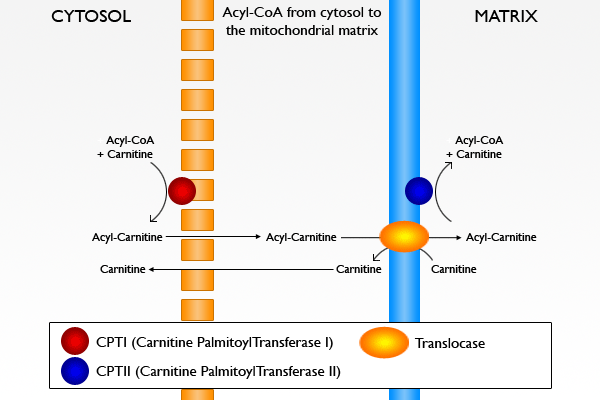
Fatty-acid metabolism disorder
Encyclopedia
A broad classification for genetic disorders that result from an inability of the body to produce or utilize one enzyme that is required to oxidize fatty acids. The enzyme
can be missing or improperly constructed resulting in it not working. This leaves the body unable to produce energy within the liver and muscles from fatty acid sources.
The body's primary source of energy is glucose, however, when all the glucose in the body has be expended a normal body digests fats. Individuals with a Fatty acid metabolism disorder are unable to metabolize the fat source for energy halting bodily processes. Most individuals with a Fatty-acid metabolism disorder are able to live a normal active live with simple adjustments to diet and medications.
If left undiagnosed many complications can arise. When in need of glucose the body of a person with a fatty-acid metabolism disorder will still send fats to the liver. The fats are broken down to fatty acids. The fatty acids are then transported to the target cells but are unable to be broken down resulting in a build up of fatty acids in the liver and other internal organs.
They are sometimes classified with the lipid metabolism disorders, but in other contexts they are considered a distinct category.
.
In addition to the fetal complications, they can also cause complications for the mother during pregnancy.
Examples include:

, and defects in this process are associated with several disorders. They involve the step immediately before oxidation, and are often grouped with the oxidation disorders.

Enzyme
Enzymes are proteins that catalyze chemical reactions. In enzymatic reactions, the molecules at the beginning of the process, called substrates, are converted into different molecules, called products. Almost all chemical reactions in a biological cell need enzymes in order to occur at rates...
can be missing or improperly constructed resulting in it not working. This leaves the body unable to produce energy within the liver and muscles from fatty acid sources.
The body's primary source of energy is glucose, however, when all the glucose in the body has be expended a normal body digests fats. Individuals with a Fatty acid metabolism disorder are unable to metabolize the fat source for energy halting bodily processes. Most individuals with a Fatty-acid metabolism disorder are able to live a normal active live with simple adjustments to diet and medications.
If left undiagnosed many complications can arise. When in need of glucose the body of a person with a fatty-acid metabolism disorder will still send fats to the liver. The fats are broken down to fatty acids. The fatty acids are then transported to the target cells but are unable to be broken down resulting in a build up of fatty acids in the liver and other internal organs.
They are sometimes classified with the lipid metabolism disorders, but in other contexts they are considered a distinct category.
Possible Symptoms
- Extreme sleepiness
- Behavior changes
- Irritable mood
- Poor appetite
- Fever
- Nausea
- Diarrhea
- Vomiting
- Hypoglycemia
- Enlarged heart
- Muscle weakness
- Heart failure
Diagnosis
Diagnosis of Fatty-acid metabolism disorder requires extensive lab testing. There are many labs that can be used for testing and diagnosing Fatty-acid metabolism disorders. Eg. http://genes-r-ushttp://genes-r-us.uthscsa.edu/parentpage.htm.uthscsa.edu/parentpage.htmCauses
Fatty-acid metabolism disorders result when both parents of the diagnosed subject are carriers of the defective genes. This type of disorder is know as autosomal recessive disorder. Two parts of a recessive gene are required to activate the disease. If only one part of the gene is present then the individual is only a carrier and shows know symptoms of the disease. If both genes are present then the disease is activated. Like most autosomal recessive disorders, when both parents are carriers, there is a 25% chance of the child gaining the disease.Types
Incomplete list of various fatty-acid metabolism disorders.- Carnitine Transport Defect
- Carnitine-Acylcarnitine Translocase (CACT) Deficiency
- Carnitine Palmitoyl Transferase I & II (CPT I & II) Deficiency
- Very Long Chain Acyl-CoA Dehydrogenase (VLCAD) Deficiency
- 2,4 Dienoyl-CoA Reductase Deficiency
- Short Chain Acyl-CoA Dehydrogenase (SCAD) Deficiency
- Electron Transfer Flavoprotein (ETF) Dehydrogenase Deficiency (GAII & MADD)
- 3-Hydroxy-3 Methylglutaryl-CoA Lyase (HMG) Deficiency
Oxidation
The term fatty acid oxidation disorder (FAOD) is sometimes used, especially when there is an emphasis on the oxidation of the fatty acidFatty acid
In chemistry, especially biochemistry, a fatty acid is a carboxylic acid with a long unbranched aliphatic tail , which is either saturated or unsaturated. Most naturally occurring fatty acids have a chain of an even number of carbon atoms, from 4 to 28. Fatty acids are usually derived from...
.
In addition to the fetal complications, they can also cause complications for the mother during pregnancy.
Examples include:
- trifunctional protein deficiency
- MCADD, LCHADD, and VLCADD

Carnitine/transport
The fatty acids are transported by carnitineCarnitine
Carnitine is a quaternary ammonium compound biosynthesized from the amino acids lysine and methionine. In living cells, it is required for the transport of fatty acids from the cytosol into the mitochondria during the breakdown of lipids for the generation of metabolic energy. It is widely...
, and defects in this process are associated with several disorders. They involve the step immediately before oxidation, and are often grouped with the oxidation disorders.


